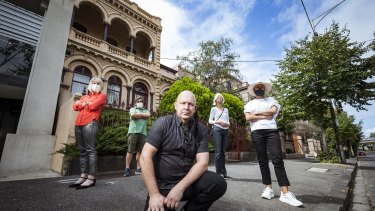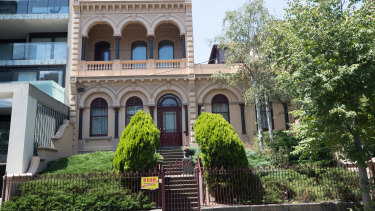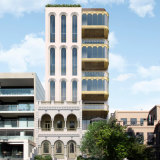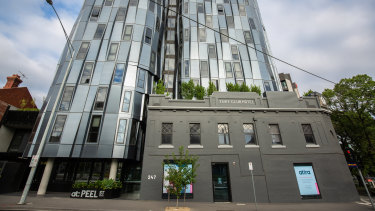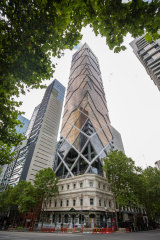Young and Jackson founder’s grand home the latest to get ‘facade’ treatment

Developers have lodged plans for the partial demolition of landmark East Melbourne mansion Eblana, built for Young and Jackson publican Thomas Jackson in 1883, to make way for an apartment tower.
At almost 42 metres, the tower would soar from behind the facade and front two rooms of the grand Italianate-style building at 140-142 Jolimont Road. The new building, home to four luxury apartments, would be almost three times the 15-metre recommended height limit for the precinct.
East Melbourne residents Greg Bisinella (centre). Nicole and Chris Pelchen, Sylvia Black and Diana Bosak outside Eblana.Credit:Chris Hopkins
Human Habitats director Will Pearce said the proposed development sought to protect the grandeur of the existing building’s frontage, while including a sympathetic design at the rear of the property.
But the application has been strongly opposed by local residents, representing the latest flashpoint in a long-running stoush between developers and heritage advocates to balance the preservation of character with new developments in historic precincts.
Eblana, the grand house built for Young and Jackson’s co-founder Thomas Jackson in 1883.Credit:Jason South
An artist’s impression of the proposed development at landmark East Melbourne mansion, Eblana.
Prompted by a raft of developments in which the facade of buildings are retained in a nod to the original heritage – while the rear of the building is demolished for modern towers – the National Trust of Australia is now drafting guidelines for heritage-sensitive development across Victoria.
The trust’s Victorian director of advocacy, Felicity Watson, said “facadism” was a poor design outcome.
Some of the most egregious examples of the practice in Melbourne include the former Celtic Club Irish pub in Queen Street, the former Turf Club Hotel in North Melbourne, and the former Palace Theatre in Bourke Street, she said.
The former Turf Club Hotel on Flemington Rd, North Melbourne.Credit:Scott McNaughton
“If you only retain the facade, or you only retain the external walls and a very small portion of the building, it removes all of the evidence of the building’s former function, its methods and materials of construction and also its ability to be understood within the streetscape,” Ms Watson said.
The National Trust says the former Celtic Club, on the corner of Queen Street and Lonsdale Street is an example of facadism being a poor design outcome.Credit:Scott McNaughton
Ms Watson said the proposed tower on Jolimont Road, East Melbourne, would dominate neighbouring buildings in its current form.
“East Melbourne is well known to have a very high number of significant 19th century buildings, and a number of very intact streetscapes and generally, we don’t want to see the erosion of that character of East Melbourne.”
By Sunday, 106 objections had been lodged with the City of Melbourne to the proposed development. A spokesman said council’s urban planners would carefully consider the application, and any development would be required to suit the area’s special local character and history.
Mr Pearce, whose company Human Habitats completed a town planning and urban context report for the City of Melbourne, said Eblana was not an “individually significant” building under current heritage guidelines.
“From a heritage response point of view, a superior outcome has been achieved than what the policy actually expects,” he said.
The role of town planning was to balance maintaining existing character and modernising the city, Mr Pearce said.
“There’s been considerable thought and effort put into the facade of the new building, and how that complements the existing heritage building on the site.”
The City of Melbourne introduced heritage policies last year, which have been approved by Planning Minister Richard Wynne, in an attempt to better protect the city’s historic buildings and precincts.
Councillor Rohan Leppert, who leads the heritage council’s portfolio, said the new guidelines – while not binding – made it clear that facadism would no longer be tolerated.
“The days of as-of-right facadism in the City of Melbourne are over,” Cr Leppert said.
“And new developments will take some time to adjust to that new reality. But we value heritage buildings in the round, in their three-dimensional form, and that’s the expectation the market will now need to adjust to.”
Greg Bisinella, who is the heritage and planning convener of the East Melbourne Group, said the proposed 42-metre development behind Eblana’s facade was disrespectful to the area’s heritage and locals were livid.
“It just sticks out like a sore thumb,” he said. “It is completely incongruent to the suburbs of Jolimont and East Melbourne.”
Mr Bisinella said retaining the building’s facade was not enough and that the internal building needed to be preserved.
“You lose the integrity of that building. It’s starting to chip away at one piece of living history, you are losing something that can’t be replaced,” he said.
Start your day informed
Our Morning Edition newsletter is a curated guide to the most important and interesting stories, analysis and insights. Sign up here.
Most Viewed in National
Source: Read Full Article

